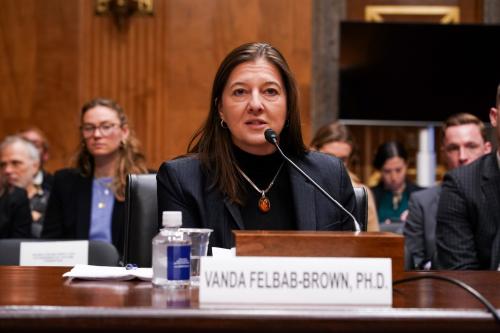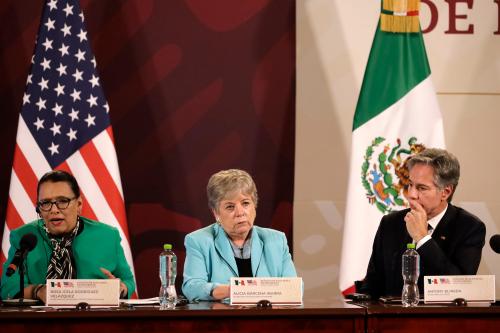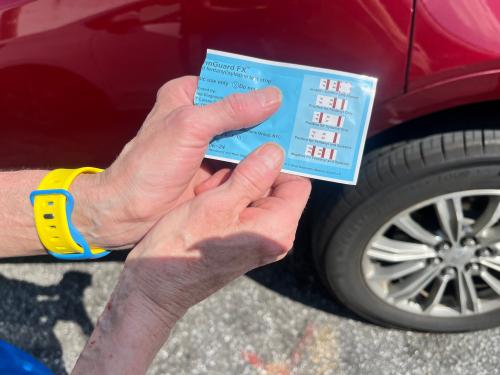Mexico has rejected the term “insurgency” to describe the current criminal violence caused by drug traffickers. In response to Mexican pressure, President Obama withdrew his characterization of the violence in Mexico as an “insurgency” in a newspaper interview just hours after Secretary of State Clinton used the term at the Council on Foreign Relations. If we are not to describe the conflict in Mexico as an “insurgency”, then we are left with the dilemma of how to describe the nature of Mexico’s current violence and what strategy to apply in countering this violence. Why is the “insurgency” term such a painful subject for Mexicans?
Historically, Mexico has converted violent periods into national moments that have contributed to the Mexican identity. For example, the civil war of the early 20th century resulted in the loss of around 500,000 Mexican people. Yet, it is remembered for the emergence of a people’s party, the Partido Revolucionario Institucional, and the redistribution of 44 million acres of land to peasant families. The brutality of this has been reinterpreted as a necessary means to end the dominance of landowners and their security forces. The ‘dirty’ war of the late 1960s and 1970s against Leftists with Marxist/Leninist tendencies saw students indiscriminately shot in Tlatelolco, the public square facing the Foreign Ministry. At the same time, peasant leaders disappeared brutally at the hands of the army. In 1994, an indigenous army, known as the EZLN and led by Comandante Marcos, sought to claim autonomy over forest lands in the southern Mexican state of Chiapas and to replace the government as it entered into the North American Free Trade Agreement. Memories of the latter two internal struggles have created within the Mexican elite, many of whom were students during the 1968 protests, a virulent rejection of “insurgent” fights.
Unlike the Marxist and indigenous struggles of the late 20th century, there are no political goals for the drug traffickers and organized criminals in Mexico. Their goals are to maximize profits and in so doing weaken the state sufficiently so it cannot interfere with their trafficking of drugs, weapons, cash, cars and people. While we should distinguish between drug traffickers and organized criminals, their profit motives and tactics are close enough that contemporary language has blended both groups into the term “drug trafficking organization” (DTO).[1] What then is the nature of the violence carried out by DTOs and what is the appropriate strategy for countering their violence? Are counter-insurgency tactics applicable to containing the violence?
The latest round of violence is perpetrated by groups with neither political aims nor ideological purpose. The DTOs compete for routes by which to ship illegal drugs into the United States. They have also developed a local market to convert their payment in drugs into cash. Recognized for their geographical dominance, the Sinaloa cartel in the west, the Arellano Felix organization, also known as the Tijuana organization on the California border, the Beltran Leyva’s organization which combats the Gulf cartel in the East, and the familia Michoacan are in a constant, dynamic and shifting war among themselves and with the federal and state authorities in Mexico. The aim of these DTOs is to hold the shipment routes and beat off any trespassers, be they another cartel or law enforcement. Until recently, profits drove their strategy, but inter-cartel rivalry and revenge against disloyal police elements have replaced their former business goal. Many liken the nature and purpose of the Mexican cartels to the Sicilian mafia.
In their transfer and distribution areas, the DTOs now demonstrate that they are more powerful than the government. Insidiously, they replace the Mexican state with their own authority, administering justice fast and effectively. Land disputes in Michoacan are not necessarily referred to the state judiciary, but are resolved and enforced by heads of la familia. Citizens in the affected communities know who keeps them safe and who administers justifiable sanctions. Consequently, many do not turn to the government to resolve their problems.
Implicitly, some government officials have been drawn into the DTO business. Either through fear or greed, law enforcement and the judicial and political authorities often work part time for a cartel. In 2010, Consulta Mitofsky found that 58 percent of those surveyed said they distrust the judicial system. Only one in 10 Mexicans hold some or much confidence in their law enforcement agencies and the police are ranked among the least respected Mexicans institutions.[2]
Instead, a pervasive fear exists among all levels of Mexican society. For example, working-class citizens go to work with nothing of value on their persons and wealthy citizens hire security guards to protect their families and businesses. Express style kidnappings target business owners and extortion affects all, including elderly women selling tortillas on street corners. The DTOs have successfully mobilized popular fear so that few dare stand up to their demands. Last month the editor of El Diario de Juarez posed a question on its front page, “Dear Narcos, what do you wish us to do to keep our journalists and friends from being killed?”[3] The DTOs may not aspire to run the government, but they have succeeded in weakening the state to the point that they can operate with impunity.
Different terms are used to describe the nature of the violence: “criminal insurgency,” “mafia wars” and the latest “selected institutional failure.” Whichever is the preferred term, we need to focus on the appropriate response. Counter-insurgency provides us with a strategy and tactical measures to pursue. Counter-insurgency is defined as “measures to secure the population and mobilize sufficient strength to allow the state to dominate.” This means that citizens must be made safe, their trust in official authorities restored and the economic wellbeing of the community rebuilt. It requires eradicating corruption from within law enforcement and providing sufficient protection so that prosecutors and judges can apply Mexican law to resolve civil and criminal cases. The military may be used to patrol highways and support civilian police, but the principal task is to restore credibility and trust in civilian institutions. Counter-insurgency also requires rebuilding the state with jobs and justice.
Such a strategy requires a six-pronged approach, most of which are being addressed with relative degrees of political will and resources:
1. Bring down the DTO kingpins and their lieutenants as they fight to replace their former leaders. In the last 12 months, nine have been captured or killed.
2. Clean corruption out of the police and install audit and control systems so that police are constantly tested for their loyalty and competency.
3. Expand the number of drug courts with protected prosecutors and judges who focus on drug cases with less fear of recrimination.
4. Demonstrate to the public that the state holds greater power than the DTOs by holding cities safe and allowing local businesses to resume trading, prospering and hiring people.
5. Address the causes of violence by investing in the education of out-of-school youth, job training in electronic communications, offering decent jobs, providing recreational spaces and strengthening public/private partnerships to support communities.
6. Respond to citizen needs to reject the violence and encourage the development of a national consensus. As part of this consensus, the wealthy should accept additional taxation to pay for sound law enforcement.
Mexico has developed most of these programs. However, an essential project is missing, namely the development of a national consensus. Mexicans must want security and they must be prepared to invest in reforming law enforcement, the judiciary and prisons. They must also be prepared to make sacrifices. In Colombia, this included the wealthy paying a wealth tax to help reform law enforcement and institutionalize a protected and credible judiciary. As long as the wealthy rely exclusively on their own protection through private security, there will be no national commitment to security. National consensus requires the recognition that the current violence affects all citizens – rich and poor – so that they come together to sustain a national commitment. To date that consensus does not exist, despite the efforts of a handful of strong Mexicans, each of whom have lost a child to kidnappers.
Most importantly, the development of a national consensus requires political leadership. That leadership must be viewed as legitimate with the ability to mobilize national will and resources. It must insist on both the rule of law and the respect for human rights. The latter provides respect to the state. Otherwise, the government rules through fear and not law. With legitimate leadership, national consensus can be created. Currently, President Calderon holds the desire, but not the capacity to win this war. He cannot permit the federal government of Mexico to “drop in” where the violence is greatest, such as Ciudad Juarez, but leave vast areas unattended. Instead, he needs to develop a comprehensive national strategy with national operations to make citizens secure and rebuild Mexico with jobs and justice. Only a long-term national strategy that persuades citizens that they can become safe will be effective. Mexicans may not wish to call this counter-insurgency, but the elements of that strategy must be constructed.
Diana Villiers Negroponte recently returned from 10 days in Mexico, visiting Ciudad Juarez, Monterrey, Oaxaca City and Mexico City.
[1] The drug trafficking organizations, known for short as DTOs do not seek to monopolize the market, but rather to dominate their competitors in the shipment and sale of illicit drugs. They do not act as a cartel, but the name has stuck in popular usage.
[2] Even less respected are legislators, political parties and unions. Consulta Mitofsky (September 2010)
[3] Armando Rodriguez, a crime reporter for El Diario de Juarez was shot in the head with a 9mm as he drove his daughter to school in late 2008. Ten journalists were killed and one disappeared in 2009.



Commentary
Op-edMexico Denies “Insurgency”: Implications for an Appropriate Response
February 14, 2011